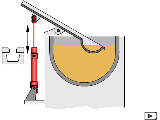[167] Exercise: Ladle (activation of a double acting cylinder)
 Liquid aluminum is
transferred from a holding furnace into a channel leading to a
die-casting machine. A ladle is required for this. A double
acting cylinder is used to enable the ladle to carry out the
appropriate movements. A circuit diagram is provided for the
activation of the cylinder with a 4/2-way valve as final control
element. This must be examined to see if it is suitable for the
control task concerned. The ladle must not be allowed to dip into
the furnace when the valve is not actuated. A circuit diagram
with a back-pressure valve must be developed to cater for the
case in which the ladle is very heavy.
Liquid aluminum is
transferred from a holding furnace into a channel leading to a
die-casting machine. A ladle is required for this. A double
acting cylinder is used to enable the ladle to carry out the
appropriate movements. A circuit diagram is provided for the
activation of the cylinder with a 4/2-way valve as final control
element. This must be examined to see if it is suitable for the
control task concerned. The ladle must not be allowed to dip into
the furnace when the valve is not actuated. A circuit diagram
with a back-pressure valve must be developed to cater for the
case in which the ladle is very heavy.
The requirements of the exercise are met by the first circuit diagram only if the ladle represents a light load. If the ladle is very heavy, the advance speed could rise to an unacceptably high level during the advance stroke of the piston rod (ladle moving towards furnace), and the ladle could as a result plunge too quickly into the molten metal. This can be prevented by installing a back- pressure valve in the B line between the valve and cylinder (tractive load).
If, as is required in this exercise, the power component must positively assume a defined end position when the installation is at rest, valves with spring return must be used, as in this case. Here, a 4/2-way valve with spring return has been used, since this ensures that the cylinder remains in the desired position if the hydraulic power unit is switched on unexpectedly. The required cylinder diameter and the return speed of the piston rod can also be calculated as additional optional tasks in the exercise: see the model calculations in the textbook.

